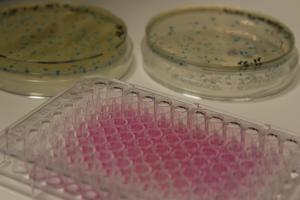
New study uncovers a promising strategy to combat antibiotic resistance
Membrane-targeting antibiotics that simultaneously block another cellular pathway are key for reducing bacterial resistance
SZEGED, CSONGRAD-CSANAD, HUNGARY, February 26, 2025 /EINPresswire.com/ -- A groundbreaking study published in Nature Communications has revealed novel insights into bacterial resistance and offers a promising strategy for developing antibiotics that minimize the evolution of resistance. Led by Csaba Pal, D.Sc. at HUN-REN Biological Research Centre, Hungary, the research team demonstrated that a dual-target approach, combining membrane disruption with an additional critical cellular pathway, significantly prevents the development of resistance in bacteria.
"Antibiotic resistance remains a critical global challenge. Even antibiotics currently in development are beginning to encounter resistance, as demonstrated in our two recent publications. This underscores the urgent need to understand the underlying principles that govern antibiotic effectiveness. By exploring these principles, we can pave the way for designing future generations of antibiotics with a reduced risk of resistance. In this work, we delve into these mechanisms, offering a potential solution to mitigate this escalating threat." says Csaba Pal, D.Sc.
Addressing a Global Health Threat
Antimicrobial resistance (AMR) is increasingly recognized as a silent pandemic, with projections estimating up to 10 million deaths per year by 2050. While developing effective antibiotics against Gram-positive bacteria is relatively straightforward, Gram-negative bacteria present a greater challenge due to their extra protective membrane, which hinders antibiotic penetration.
Key Findings
Rational dual-target strategy:
This dual-targeting approach, termed "Dual target permeabilizer”, has shown the lowest levels of resistance emergence in critical pathogens, such as Escherichia coli, Klebsiella pneumoniae, Acinetobacter baumannii, and Pseudomonas aeruginosa, identified by the World Health Organization (WHO).
The lead author Elvin Maharramov explains: “By combining membrane disruption with another key cellular pathway, we can dramatically limit bacterial resistance. This highlights that which targets matter just as much as how many”.
Laboratory and environmental evidence:
In laboratory evolution experiments, dual target permeabilizers consistently resulted in lower resistance levels compared to antibiotics that solely target the bacterial membrane. This group includes the last-resort polymyxin antibiotic and its yet-to-be-announced derivative, SPR206. Other dual-target antibiotics lacking membrane permeabilization exhibited median resistance levels up to 128 times higher. Furthermore, environmental samples, crucial for understanding real-world applications, revealed significantly fewer resistance genes associated with dual target permeabilizers. Notably, no resistance determinants were detected against tridecaptin M152-P3, whereas even antibiotics not yet released for public use already showed traces of resistance, underscoring the urgent need for improved drug designs.
A framework for the future:
Co-lead author Marton Czikkely comments: “Antibiotics that permeate the outer membrane of bacteria by targeting lipopolysaccharide (LPS) have long been used in clinics. However, bacteria can quickly evolve resistance against them, even to last-resort antibiotics like colistin. Our study proposes a resistance-proof mechanism using mechanosensitive channels, as seen with SCH79797 targeting mscL.”
This innovative mechanism of action could pave the way for developing next-generation antibiotics that are effective against multidrug-resistant Gram-negative pathogens.
Implications for Global Health
By demonstrating that a rational dual-target approach can substantially reduce the risk of resistance, this study provides a vital new direction in the fight against AMR. The research not only advances our understanding of bacterial resistance mechanisms but also lays the groundwork for developing safer, more effective antibiotics to protect public health worldwide.
Dr. Pal Csaba
HUN-REN Biological Research Centre, Szeged
+36 30 465 2785
email us here
Visit us on social media:
X
LinkedIn
Other
Distribution channels: Chemical Industry, Education, Environment, Healthcare & Pharmaceuticals Industry, Science
Legal Disclaimer:
EIN Presswire provides this news content "as is" without warranty of any kind. We do not accept any responsibility or liability for the accuracy, content, images, videos, licenses, completeness, legality, or reliability of the information contained in this article. If you have any complaints or copyright issues related to this article, kindly contact the author above.
Submit your press release


